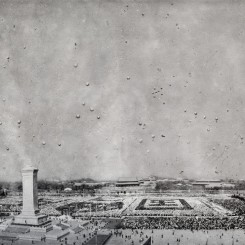Ground Control to Major Zhang
Art History
While he is careful to maintain the photographic light of the source images, compositions often recall classical works from the Western tradition, particularly 17th Century French and Flemish realist painting, such as the Le Nain Brothers and Frans Hals. In “Division Meeting” (2009) note the dramatic use of the central candlelight, the reverential atmosphere and even the headscarf, reminiscent of examples depicted in Flemish painting from Vermeer onwards. In the same year, Zhang painted “The Night Watch,” the title homage to Rembrandt’s of 1642, but with “soldiers” traipsing a field with flaming branches more ominous (so too “Nightraid” (2008) with soldiers wading ashore up to their necks in water, two raising hands in greeting — but it is ash they are up to their necks in, so are they calling for help?)
In the White Cube show there are many examples of echoes from Western art history. “Operating Table” and “Conference Room” (both 2008) bear similarities to nineteenth-century French and American social realism, notably Thomas Eakins, but ominously without the patient or participants — too early or too late? — what has been decided? In the “Flag” series, versions of the Chinese and American flags (Zhang’s two “homes”), inevitably refer to Jasper Johns, “American Flag No. 9” (2010). Zhang’s “Weeping Angels” refer to Yves-Klein’s “Anthropometry Performance” paintings. The giant earthwork landscapes, such as “Grand Canal” (2009), obliquely recall Robert Smithson and Michael Heizer, while the horizon-less “Sea No.1” (2011) recalls Gerhard Richter’s abstract-realist ocean paintings.
Zhang also references, even critiques, his fellow artists. Like Ai Weiwei’s acts of iconoclasm, such as “Dropping the Urn” (1995/2009) or “Colored Vases” (2007-2009)— both involving Han Dynasy urns — Zhang’s “Memory Doors” and reclaimed bricks transform antique objects through partial destruction. Like Zhang Xiaogang, Zhang Huan elevates the private history of ordinary families under Communism. Zhang’s “Q Confucius” exhibition played on Cai Guo-Qiang’s automaton artists in “Peasant da Vincis” exhibition that preceded Zhang’s at Shanghai’s Rockbund Art Museum.
He is acutely sensitive to the need to define his and China’s space in (world) art history, and that means distinguishing himself from his comrades. This can lead to charges of egotism, yet the criticality that motivated his visceral early performance pieces, such as 1993’s “Weeping Angels,” at the China National Art Gallery, which involved the symbolic abortion of broken baby-dolls and copious blood, remains.
The intention is not to pay slavish respect to the canon of art history. Rather Zhang’s paintings present the conflict between memory and history — in China, a real conflict. We see “Rui Yuan,” (2010) in military uniform, another military figure. But this was the childhood nickname of General Chiang Kai-Shek. The anachronistic reference recalls the time before Chiang was a nationalist leader, a national hero, and then a defeated reactionary, who later became an exiled revanchist and autocratic enemy. The work is about the time before memory is formed, more precisely the memory before that memory. Really, to speak of generic or historical themes in Zhang Huan’s ash paintings is to engage in a false dichotomy, because the historical is generic and the generic is historical — ordinary people, heroes, leaders together. As much is inferred by the ambiguous “Kite Call,” a nostalgic seaside scene, not out of place in countless minor Impressionist paintings of the late-nineteenth and early-twentieth century, except that it also presents a propagandistic image of propagandistic slogans.
Silence
The unusually etiolated “My Literary Teacher” (2008) is tonally nostalgic but shadowed by the rejection of accepted social norms of authority and instruction: during the Cultural Revolution many schoolteachers were attacked, humiliated, defenestrated, even killed.
The more expressionistic “Graduation” (2011) begs the questions “from what?” and “to what?” — two anonymous fates. Similarly, in “Sworn Sisters” (2011), two apparently genetic sisters are categorized as “sworn sisters” but against what? For what purpose is such a bond necessary? (4) “36 Years Old,” shows a man in the 1920s. It presages the Japanese invasion, the civil war, the Great Leap Forward and Cultural Revolution. What then was he like in the 1970s, when we would have been 86 years old?
__________________________
4. Here Zhang Huan is also critiquing the saccharine and anodyne realism that pervades the Chinese auction rooms: it’s just a black and white portrait, a document — no swooning jeunes filles in pristine ethnic costume hard at work with happy, happy smiles. Further, simply showing two sisters references China’s one-child policy and the disturbingly disproportionate number of boys versus girls, due to abortion and post-natal murder of “uneconomic” girls.



